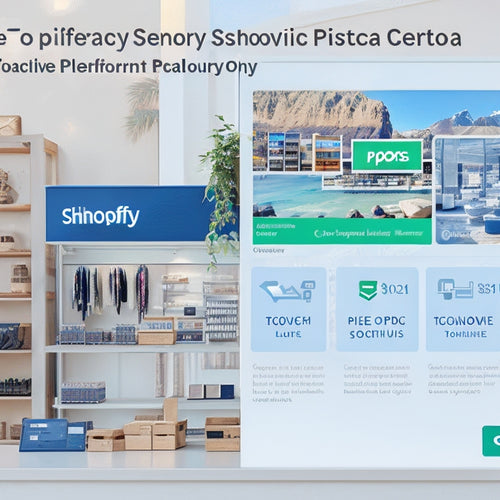
Marketplace Strategies Drive Automotive Industry Growth
Share
The automotive industry's growth is being driven by marketplace strategies, with mobile shopping trends, innovative business models, and data-driven strategies converging to create a thriving ecosystem. Over 50% of automotive shoppers research products on mobile devices, making quicker purchase decisions and driving higher conversion rates. The rise of mobile shopping has led to the evolution of traditional sales models, with businesses adapting to changing customer preferences through hybrid models. By leveraging data analytics, businesses can access growth potential, refine marketing strategies, and improve inventory management. As the industry continues to shift, one thing is clear: the key to success lies in embracing these strategic transformations.
Key Takeaways
• The automotive industry is shifting towards online marketplaces, driven by over 50% of shoppers researching products on mobile devices.
• Marketplace strategies, such as dynamic pricing optimization and service collaborations, accelerate growth and revenue diversification.
• Optimizing mobile interfaces and implementing mobile payment options increase conversions and revenue, as mobile users make quicker purchase decisions.
• Effective inventory management and strategic partnerships are essential elements for a thriving marketplace ecosystem, ensuring a seamless shopping experience.
• Data analytics uncovers hidden patterns, preferences, and trends, driving data-driven decisions and business growth in the automotive industry.
Mobile Shopping Trends
As the automotive industry increasingly shifts towards online marketplaces, mobile shopping trends have emerged as a key driver of growth, with over 50% of automotive shoppers now researching products on mobile devices, and mobile users making quicker purchase decisions compared to their desktop counterparts.
This shift is pivotal, as mobile conversion rates are notably higher when compared to desktop conversions. Understanding mobile buying behavior is essential for businesses to capitalize on this trend. By optimizing mobile interfaces and implementing mobile payment options, businesses can streamline the buying process, leading to increased conversions and revenue.
Additionally, analyzing mobile user data can provide valuable insights into customer preferences, enabling businesses to tailor their marketing strategies and improve overall customer experience.
Marketplace Ecosystem
With the rise of mobile shopping, the automotive industry's shift towards online marketplaces has created a complex ecosystem where merchants, operators, and customers interact and influence one another, ultimately driving growth and revenue.
This delicate balance is maintained through ecosystem dynamics, where each stakeholder plays an essential role in guaranteeing a seamless shopping experience.
To foster a thriving marketplace ecosystem, consider the following key elements:
-
Strategic marketplace partnerships that bring together complementary businesses and services.
-
Effective inventory management to ensure a diverse range of products and services.
-
Streamlined payment processes to reduce friction and increase conversions.
- Robust data analytics to provide valuable insights and drive informed decisions.
Business Model Evolution
The automotive industry's traditional sales model is giving way to innovative marketplace approaches. Businesses are adapting to changing customer preferences and behaviors by embracing hybrid models that combine the strengths of both. This evolution is driven by the need for platform integration, customer engagement, and revenue diversification.
The traditional model involved direct transactions between buyers and sellers, offering limited product variety and revenue streams. It also had limited scalability and customer reach. In contrast, the marketplace approach features multiple sellers on a single platform, increased product variety, and diversified revenue streams such as commissions, subscription fees, and advertising. It also offers scalability and flexibility for businesses of all sizes, along with a wider reach to potential customers beyond geographical limitations.
Growth Acceleration Strategies
By leveraging the advantages of marketplace models, businesses can accelerate growth through strategies that expand their customer reach, optimize pricing, and enhance the overall shopping experience.
To achieve this, businesses can implement the following growth acceleration strategies:
-
Dynamic pricing optimization, allowing for real-time adjustments to stay competitive and attract buyers.
-
Service collaborations, partnering with complementary service providers to enhance the customer experience and increase loyalty.
-
Targeted marketing campaigns, utilizing data analytics to identify and target high-value customer segments.
- Streamlined checkout processes, reducing friction and increasing conversions through user-friendly interfaces and mobile optimization.
Leveraging Data Analytics
Marketplace operators can access significant growth potential by leveraging data analytics to uncover hidden patterns, preferences, and trends that inform their business strategies and optimize the customer experience.
By analyzing customer data, operators can gain valuable customer insights that enable data-driven decisions, ultimately driving business growth. This includes identifying popular products, tracking customer behavior, and detecting emerging market trends.
With data analytics, operators can refine their marketing strategies, improve inventory management, and create personalized experiences that foster customer loyalty. By harnessing the power of data, marketplace operators can make informed decisions that propel their business forward, ensuring a competitive edge in the automotive industry.
Digital Commerce Essentials
In today's digital landscape, a deep understanding of digital commerce essentials is essential for automotive businesses to remain competitive, as they navigate the complexities of online sales and customer engagement. To thrive in this space, businesses must prioritize customer engagement by providing seamless and secure online experiences.
Here are four key digital commerce essentials to focus on:
-
Developing e-commerce skills: Investing in user-friendly interfaces, mobile optimization, and data analysis to drive conversions.
-
Enhancing customer engagement: Leveraging social media and digital marketing channels to boost brand visibility and encourage customer interaction.
-
Streamlining online transactions: Implementing mobile payment options and ensuring secure transactions to build trust with customers.
- Embracing continuous learning: Staying up-to-date with the latest technologies and market trends to stay competitive in the digital commerce landscape.
Navigating Industry Disruption
As the automotive industry undergoes a significant shift towards digital commerce, businesses must adapt to emerging trends and technologies to stay ahead of the curve.
The industry transformation is driven by disruptive technologies that are reshaping the way vehicles are bought, sold, and owned. Electric vehicles, autonomous driving, and mobility-as-a-service are just a few examples of innovations that are forcing traditional players to rethink their strategies.
To navigate this disruption, companies must be agile, responsive, and open to new business models and partnerships.
Frequently Asked Questions
How Do I Measure the Success of My Automotive Marketplace Platform?
Measuring success is like driving a precision-crafted vehicle, requiring a clear dashboard of performance metrics, including customer satisfaction ratings, growth analysis, and revenue tracking, to guarantee a safe and profitable journey for your automotive marketplace platform.
What Are the Most Common Pain Points for Automotive Marketplace Customers?
Automotive marketplace customers often experience pain points related to pricing transparency, with 70% citing unclear or misleading pricing as a top frustration, highlighting the need for customer-centric pricing strategies to guarantee satisfaction and build trust.
Can I Integrate My Existing Inventory Management System With a Marketplace?
When integrating an existing inventory management system with a marketplace, businesses often face integration challenges and inventory synchronization issues, requiring careful planning and API connectivity to guarantee seamless data exchange and accurate product availability.
How Do I Handle Product Returns and Refunds in a Marketplace Model?
To guarantee customer satisfaction, implement a clear return process with easy refunds, while maintaining fraud prevention measures, such as verifying returns and enforcing refund policies, to build trust and minimize losses in your marketplace model.
What Are the Key Performance Indicators (Kpis) for Automotive Marketplace Operators?
As operators navigate the complex automotive marketplace landscape, key performance indicators (KPIs) such as customer engagement metrics, conversion rates, revenue growth, and user retention rates emerge as vital benchmarks to measure success and inform data-driven decisions.
Related Posts
-

Integration Shopify Apps Ensure Smooth Interoperability Between the Store and Various External Tools or Platforms Such as POS Systems and Crms
The integration of Shopify apps plays a crucial role in ensuring smooth interoperability between the store and vario...
-

How Do I Optimize My Shopify Store for Sales
This article aims to provide an informative and analytical overview of the process of optimizing a Shopify store for...
-

Boost Your Business With Top-Rated Shopify Integrations
This article explores the benefits of utilizing top-rated Shopify integrations to enhance business performance. Shop...


